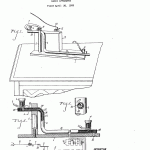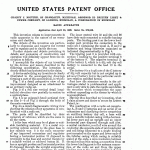Chancy J. Britten – Radio Apparatus – patent 1,826,727
Inventor: CHANCY J. BRITTEN
Original Assignee: BRITTEN LIGHT a POWER COMPANY
Current U.S. Classification: 455/281; 455/343.1
Patent number: 1826727
Filing date: Apr 30, 1928
Issue date: Oct 13, 1931
This invention relates to improvements in radio apparatus in the nature of an economizer and clarifier.
The objects of the invention are particularly to economize and conserve the current and to regulate and to clarify the tone.
Further objects and objects pertaining to details and economies of construction and operation will definitely appear from the description to follow.
I accomplish the objects of my invention by the devices and means described in the following specification. The invention is clearly defined and pointed out in the claim.
A device embodying my invention is clearly illustrated in the accompanying drawings forming a part of this specification, in which:
Fig. 1 is a detail perspective view of my improvement designed as an attachment to 20 an ordinary radio set.
Fig. 2 is a full size vertical detail longitudinal elevation view partially in section on a central plane.
Fig. 3 is an enlarged detail sectional view on line 3—3 of Fig. 2 through the body of the main connection.
Fig. 4 is a detail diagrammatic wiring view showing the relation of my apparatus in combination with a radio set.
The parts will be identified by, their numerals of reference which are the same in all the views.
1 is the base which may be of glass or suitable insulating material. 2 is a metal supporting column secured to the glass base in any suitable way. 3 is the main connector of my improved economizer and regulator having a horizontal portion 31 disposed in proximity to the base and secured thereto by a suitable welded or soldered button 32. It has an upright portion and horizontal portion 33 disposed through the upright supporting post 2. This connector comprises an outer tube or casing 34 preferably of copper, an inner central wire 35, around which is disposed a coil of wire 36. The coih of wire is embraced within a layer of mica insulating material 37. The tube is preferably under partial vacuum. Plugs 38 of insulation are 50 in the ends of connector 3.
The inner central wire 35 and the coil 36 have their ends connected to suitable binding posts. The binding post 4 on the lower horizontal part provides the connection to the radio set 5 containing the usual A, B and C batteries and being otherwise organized as indicated diagrammatically in Fig. 4.
The binding post 6 is provided with connection 7 leading to the positive terminal 8 of the battery 9. The negative terminal 11 of the battery 9, which is a 4y2 volt dry cell battery is connected to the lead 10 to the aerial.
The battery 9 is a duplicate of the C battery of 41/2 volt capacity but is not coupled up to act as a C battery but in the particular auxiliary relation specified herein.
Just how the structure results in the advantages stated is problematical and applicant is only able to state the results and define the structure which accomplishes the same without expanding on the theory by which it is accomplished.
Having thus described my invention, what I claim as new and desire to secure by Letters Patent, is:
The combination with a radio set comprising A, B and C batteries and an aerial of an economizer and clarifying device comprising an auxiliary battery dry cell, a base with post, a metallic tubular casing with a horizontal lower part and an upright and an upper horizontal part disposed through said post, a central conductor, a coil of wire around the conductor, the opposite ends of said conductor and coil being connected to a single binding post mounted on the upper and lower ends of the tubular casing which casing is suitably sealed at the ends, a mica insulation between the said coil and the casing, a connection from the lower binding post to the antenna connection of the radio set and from the upper binding post to the positive terminal of said battery dry cell, and a connection from the negative terminal of the said battery cell to the aerial or antenna of said radio set.
In witness whereof I have hereunto set my hand.
CHANCY J. BEITTEN.











